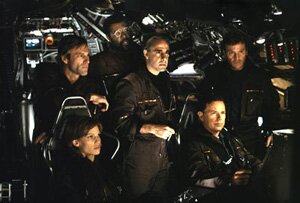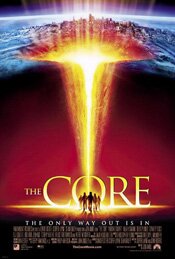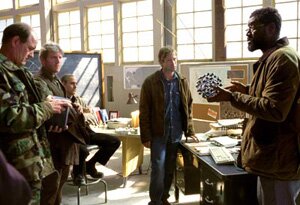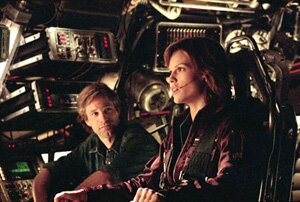There are certain movies I can make a reference to and people immediately know the film and usually recall it with a smile — if not outright laughter. Dirty Rotten Scoundrels is one of those movies. It didn’t change the world of movie making when it came out and didn’t win any awards. It simply did what most movies hope to do: get seen, be appreciated and remembered.
Cautionary tale: Kingdom of Heaven
Ridley Scott likes his movies big. In 2005, he made one of them — an old school sword-and-sandals epic called Kingdom of Heaven that despite its action scenes and moments of brutal violence, is overall a surprisingly quiet, thoughtful cautionary tale about the hazards of extremes.
20 movies: The Core (2003)
 It’s summer. Surely that calls for a “popcorn” movie? I suggest The Core (2003), a “world facing imminent destruction that only a well chosen quirky few can save it from,” kind of movie.
It’s summer. Surely that calls for a “popcorn” movie? I suggest The Core (2003), a “world facing imminent destruction that only a well chosen quirky few can save it from,” kind of movie.
You don’t look to disaster movies for credibility. A disaster movie that takes itself too seriously … now that is a genuine disaster. They’re suppose to be fun and you are suppose to watch them with your brain turned off. When they are well made, they are fun. And there’s a great sense of relief in turning off the mental works every now and again.
The Core doesn’t have the best special effects but neither does it have the worst. It does, however, have some very good actors and while movies like this aren’t famous for great dialogue or character delineation, the actors here manage to bring something more to an otherwise two-dimensional script.
In other words, I like this movie. Sue me. 
 The Core
The Core
directed by Jon Amiel
Simply put, The Core is a guilty pleasure. I watch a disaster movie like this and think, “This is junk. I shouldn’t like it.”
But I do. Sometimes junk is exactly what you want. And when you’re in that mood, nothing fills the bill better than well-made junk.
And that is what The Core is: well-made junk.
The movie starts with the world going wonky. People with pacemakers suddenly drop dead and for no apparent reason. In Trafalgar Square, birds go mad, swirl wildly, fly into people and buildings, and die.
Called in my the U.S. government, a brilliant university professor (Aaron Eckhart) goes, “Hmmm.” He divines that the earth’s electromagnetic (EM) field is going all to hell. After some pondering, it’s discovered the Earth’s core has stopped spinning (made of two layers — inner solid, outer liquid — the movement of the inner is what creates the EM field, we’re told).
What to do? As it turns out, the answer is to travel to the core and jump start the laval ring with nuclear bombs. (Seems obvious, right?)
 The plausibility of any of this is irrelevant. Movies of this kind are not about reality. They are essentially fantasies, science fantasies, and we’re expected not to question too much. It’s part of the bargain you make when you sit down with this kind of a film.
The plausibility of any of this is irrelevant. Movies of this kind are not about reality. They are essentially fantasies, science fantasies, and we’re expected not to question too much. It’s part of the bargain you make when you sit down with this kind of a film.
And that’s okay. You don’t watch these movies for the credibility of the extrapolations. You watch them for the thrill, the special effects, the suspense.
The Core delivers on all of these, though the special effects are … well, not top of the line. I think the movie works because it is well-paced. It seldom lets up; once you’re strapped in to your chair, agreed to the suspension of disbelief, you’re there for the duration. The g-force of the pace keeps you in your seat.
 But The Core also works because it gets such good performances from a well-chosen cast.
But The Core also works because it gets such good performances from a well-chosen cast.
In this kind of movie, the characters are all caricatures. There is not a great deal of depth to any of them. But with a good cast they flesh out and transcend their two-dimensional quality and become compelling.
As the DVD features reveal (a “Making of” featurette) the director, Jon Amiel, was focused on the characters. He wanted to make a popcorn disaster movie but with more character emphasis than normally associated with these kinds of movies.
It’s not surprising from Amiel, given his background. As this part of his IMDb bio says, “After studies in English literature, Jon Amiel graduated from Cambridge University and ran the Oxford and Cambridge Shakespeare Company, which often toured the USA. He became the Hampstead Theatre Company’s literary manager and began directing there, relocating to the Royal Shakespeare Company.”
Yes, I can see why there is a focus on performance. For example, Bruce Greenwood gets what might be a thankless role as Commander Richard Iverson, the stereotype of the all-American good guy, a tremendously dull role. But Greenwood is so good in it, so compelling and credible, the character becomes interesting and you sort of wish he had been the one playing the President in Independence Day. (On the other hand, he’s such a good actor we probably shouldn’t wish such bad lines on him.)
 Hilary Swank also plays her part perfectly and again in what might have been a pretty colourless role. Once more, the all-American hero is what is called for, the good guy (or gal). Yet she manages to enunciate certain nuances to give the character a depth it might not otherwise have.
Hilary Swank also plays her part perfectly and again in what might have been a pretty colourless role. Once more, the all-American hero is what is called for, the good guy (or gal). Yet she manages to enunciate certain nuances to give the character a depth it might not otherwise have.
Of course, this isn’t to say the movie is a character study – far from it. But in this kind of a film, great performances add a dimension to the film that it otherwise would not have had and make it much more engaging.
The movie also boasts two of my favourite actors, both of whom give wonderful performances as eccentrics of a kind: Delroy Lindo as a desert-living, oddball scientist and Stanley Tucci as the other great American scientist, celebrated and feted wherever he goes, and who has the misfortune of being an enormous, self-centred ass. Both Lindo and Tucci add tremendously to the film.
Like any guilty pleasure, The Core is the kind of movie you feel a little embarrassed liking. But it’s unashamed junk and revels in its quality as such. Like movies such as Anaconda and Independence Day, it is simply a fun ride.
Who cares if it makes sense?
The Core (trailer)
20 movies: Insomnia (2002)
You may have heard of a guy named Christopher Nolan.
He’s directed a few movies such as Batman Begins, The Dark Knight and the currently in release, Inception.
He made his first really big splash with a movie called Memento (2000). Insomnia is a relatively lesser known movie he made. It’s the one he made after Memento.
Nolan is a director Hollywood must love. He has artistic stature because his films are creative and brilliantly constructed. Better still, for Hollywood, they are often big successes at the box office. What could be better?
Insomnia is a movie that is a bit lost in his body of work but one well worth seeing. It had some baggage when it came out: 1) it was the film that followed the brilliant Memento, 2) it was based on a Norwegian movie of the same name, thus suffering from comparisons, 3) it had the go-to guy for weariness, stress and/or crankiness, Al Pacino, an actor who suffers from being so good at portraying those kinds of characters the world often parodies them and thus obscure the quality of his performances.
But make no mistake, this is a really good movie and the performances are even better. Unfortunately, my review below doesn’t really do it justice. I wouldn’t call this a great movie; it’s a good one. However, amongst good movies it’s heads above the others.
Insomnia
Directed by Christopher Nolan
I’m at an advantage in that I’ve never seen the original, Erik Skjoldbjærg movie Insomnia. The truth is, I knew almost nothing about the Christopher Nolan film of Insomnia. I picked it up as a PV disc (previously viewed). Well, was I ever pleasantly surprised.
Of recent films, it’s one of the best to be released on DVD this year. It’s exciting, intriguing and intelligent. It’s shot beautifully, skilfully constructed, and gets great performances from its entire, well-chosen cast.
It’s very mysterious. While you know what the surface story is about, a murder and a cat-and-mouse game between the killer and a detective, you’re never quite sure what the undercurrents are about, not till the very end. And the movie is about those undercurrents.
While their department is undergoing an internal investigation back in L.A., two detectives are sent to Nightmute, Alaska, to help solve a murder case. While there, they set a trap for the killer.
He shows up but escapes in a heavy fog.
During the confusion of the chase in the fog, one detective (Al Pacino as Will Dormer) shoots and kills the other (Michael Donovan).
It appears to be an accident, but as the movie unfolds this becomes unclear.
Detective Dormer’s troubles then begin to snowball: the investigation in L.A., the investigation into the shooting of his partner, and a growing relationship with the killer, Robin Williams.
The killer appears to know some of Dormer’s secrets so he has a power position, which he uses. He plays with Dormer, trying to get the detective to help him deflect guilt in the murder he’s committed.
As all this is going on, Detective Dormer can’t sleep. He’s far north, and it’s in the late spring of the year, so it is daylight almost constantly. Struggle as he might, he can’t evade light; he can’t find sleep.
He starts unraveling and Pacino plays it dead on, showing us in his face the stress and anxiety the detective is experiencing.
The movie is about guilt. The light acts as a kind of spotlight in the film. No matter what Dormer does, he’s anxious he’s going to be found out.
Wonderfully constructed, played and executed, Insomnia is a very good movie.
Insomnia (the trailer)
20 movies: Tombstone (1993)
I can think of no better place to start my list of twenty movies than with one of my favourite kinds of movies, the western, and specifically one of my favourite westerns, Tombstone from 1993. If you want something to watch this summer, try this one.
While there are many aspects to the movie that are excellent, the one that truly stands out is Val Kilmer’s portrayal of Doc Holliday. If you have never seen the movie, or if you haven’t seen it in a few years, it’s time to watch one of the great performances. In some ways, Tombstone is a variation of The Man Who Shot Liberty Valance and Kilmer’s Holliday is a new take on John Wayne’s Tom Doniphon.
Here’s my review of the movie that I wrote a few years ago:
Tombstone
directed by George P. Cosmatos
This movie frustrates me because I don’t know what to write. It’s one of the best westerns I’ve ever seen and, to be truthful, that’s really all I have to say about it.
Of course, I love westerns. But I’m not sure why. I think it’s because of the simplicity of the stories and the fact that they are, essentially, all mythical.
I suppose you could say this about all movies but westerns, in particular, access mythic elements and use them to engage us. They really are the same damn story played over and over again.
The best westerns do this; the least successful ones try to play with the genre.
Having said that, I think director George P. Cosmatos and writer Kevin Jarre do play with the genre just a tad … but they rigidly adhere to the essential elements. For example, one of the staples of westerns is the opening when the bad guys come in and do something really, really bad. I can’t think of a single Clint Eastwood western that doesn’t do this. What this does is immediately set the context of the movie – a wild and lawless landscape that is crying out for order.
The next step is to introduce us to the good guy (or guys) who are reluctantly drawn in and eventually save the day.
Simple stuff, and exactly what Tombstone does.
But within this simple framework, Cosmatos and Jarre do much more. Chiefly, they give us characters with much greater delineation and far more contradictions that the average B western.
In particular, we get the incredible performance of Val Kilmer as Doc Holliday. It’s not the usual Doc Holliday; this one is true to history and, within that, Kilmer gives us perfect and unexpected nuances.
And while the Doc Holliday character may be the one we walk away remembering best, Kurt Russell’s Wyatt Earp is equally masterful. He’s less interesting only because his character is the good guy. But he has his own contradictions and, more importantly, it’s the apparent paradox of his relationship with Doc Holliday around which the movie revolves and succeeds.
There are, of course, a few minor problems with the film, as with all movies. For example, there is the scene when Bill Paxton as the youngest Earp, Morgan, is shot and Kurt Russell is with him. Russell’s hands and arms are covered in blood. He runs his hands over Paxton’s forehead – he seems to touch just about everyone in the place, including himself – yet no blood rubs off on anyone. Huh? How’d that happen?
But it’s a quibble. The movie is pure western, from setting to music to story. It also avoids that sepia nonsense so many westerns have. Rather, they have shot this movie to show the colour of the mythic west and it’s a tremendous relief to see a western with this much confidence in itself as a western.
Tombstone (the trailer)


